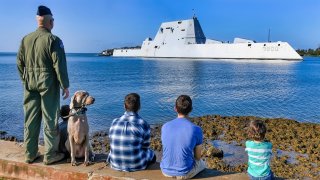The U.S. Navy's New Nightmare: Is the Era of the Big Warship Over?
The U.S. Navy's future will likely see smaller, faster warships armed with missiles rather than big guns. Those vessels will be supported by unmanned vehicles in the air, on the surface, and under the water. But yes, the era of big, expensive warships like battleships is long over.
The Future of Warships: Lessons from the U.S. Navy's Engagement with Houthi Rebels: On Monday, the United States Navy conducted six defense strikes and fired 18 anti-ship missiles in Yemen in response to two anti-ship ballistic missiles that were fired by the Iranian-back Houthi rebels into the Red Sea.
The Future of Warships: Lessons from the U.S. Navy's Engagement with Houthi Rebels
"Between 2:50-11:30 p.m. (Sanaa time) on March 11, United States Central Command conducted six self-defense strikes destroying an unmanned underwater vessel and 18 anti-ship missiles in Houthi-controlled areas of Yemen. It was determined these weapons presented an imminent threat to merchant vessels and U.S. Navy ships in the region. These actions are taken to protect freedom of navigation and make international waters safer and more secure for U.S. Navy and merchant vessels," The United States Central Command (CENTCOM) announced.
Since the U.S. Navy began its campaign of airstrikes launched in January, it has shot down and destroyed more than 100 Houthi missiles, according to an Associated Press analysis – yet, the onslaught from the Houthi rebels has shown no signs of abating.
It bears repeating, the brave sailors on the U.S. Navy vessels need to do everything right, every single time – and an enemy only needs to get lucky once. The Houthis are now clearly playing a "long game," hoping that one time they'll actually get lucky. If – and hopefully there is not a when – such a moment occurs, America's adversaries will take note, as will the world.
It won't be remembered that a hundred missiles were destroyed. All it will take is for one to make that lucky shot. Even minimal damage would be "proof" that the U.S. Navy isn't invincible.
This begs the question, "Is the era of the big, expensive warship over?"
The answer is complex.
The fact remains that frigates today already operate with vastly smaller crews than they did just a few decades ago, and will likely continue to shrink in size. At the same time, the weapon capabilities of those warships have increased. Thus, the era of the battleship and large cruisers has long since passed, and warships will simply need to adapt as they always did.
Fool to Fight a Fort – But Foolish to Think We Can Do Without Warships
The Royal Navy's Lord Admiral Nelson famously argued "A ship's a fool to fight a fort," but he was clearly proven wrong in how warships played a vital role in providing the firepower to allow for a successful amphibious invasion. World War Two's D-Day landings in Normandy, France, and the island-hopping campaign in the Pacific couldn't have occurred without the big guns from the battleship. Nelson can be forgiven for not being a forward thinker, and his comments were made more than 150 years earlier.
Yet, other forward thinkers, such as U.S. Army General Billy Mitchell, predicted the days of those massive behemoths would be superseded by aircraft. His portent to the potential of aviation was proven right as nearly two dozen battleships were sunk by aircraft during the Second World War. By contrast, only one aircraft carrier was sunk by a battleship – the HMS Glorious, which was retired as a battlecruiser and reconstructed as an aircraft carrier.
Yet, the real death knell for the capital ships in the Cold War was that it was determined that carrier-based aircraft and guided-missile cruisers could do the job more effectively than large battleships.
Thus we should recognize the fact that land-based missiles won't completely single the end of warships. Instead, the technology of warships will simply evolve.
The introduction of cannons didn't mean the end of warships. Instead, the wooden ships grew in size and were armed with more guns. That eventually led to the era of ironclads and then to steel warships, which further grew in size – with HMS Dreadnought ushering in the short-lived era of the modern battleship.
Bigger was better, at least until it wasn't.
Thus, the future will likely see smaller, faster warships, armed with missiles rather than big guns. Those vessels will be supported by unmanned vehicles in the air, on the surface, and under the water. But yes, the era of big, expensive warships like battleships is long over.
Even aircraft carriers may need to adapt given the advances in land-based "carrier killer" missiles. While carrier strike groups will continue to have a place in the world, those too will likely evolve. The future CSG will also likely employ drones and other systems, while the flattops and escorts will be armed with lasers to counter enemy drones, missiles, and aircraft.
The future U.S. Navy – and all naval forces for that matter – will likely be unrecognizable, but it will be an evolutionary rather than revolutionary step forward.
Author Experience and Expertise: Peter Suciu
Peter Suciu is a Michigan-based writer. He has contributed to more than four dozen magazines, newspapers, and websites with over 3,200 published pieces over a twenty-year career in journalism. He regularly writes about military hardware, firearms history, cybersecurity, politics, and international affairs. Peter is also a Contributing Writer for Forbes and Clearance Jobs. You can follow him on Twitter: @PeterSuciu. You can email the author: [email protected].


